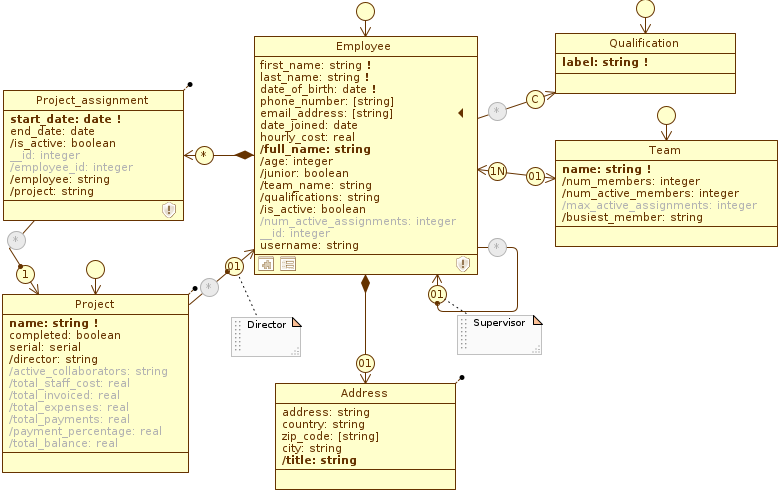Reference engine model #
All examples on this page reference the engine model in figure:

The Employee class, center, as modeled in the Tutorial.
The Employee class has system versioning enabled.
lock and unlock services. #
In order to support concurrent change scenarios, the GraphQL schema offers two services that allow you to acquire or release locks on the database concerning one or more objects: Mutation.lock and Mutation.unlock.
type Mutation {
lock(locks: [EntityID!], minutes: Int = 10): LockStatusResult
unlock(locks: [EntityID!]): LockStatusResult
}
Unlike other services, these are model-independent in that they are not bound to a specific class. Both require a list of input type of type EntityID as input, and return the LockStatusResult structure as output. Let’s examine them in order:
input EntityID {
entityName: EntityName!
_id: ID!
}
The input EntityID represents a database object identified by its ID and class name, given in the entityName field. This is of type EntityName, an enum containing a value for each class present in the GraphQL schema. For example, for reference model, EntityName contains the following values:
enum EntityName {
Address
Employee
Project
Project_assignment
Qualification
Team
}
Every EntityID is is moreover meant to univocally identify a resource to lock or release the lock on. Let’s examine the output LockStatusResult:
type LockStatusResult {
locked: Boolean!
minutes: Int!
}
This structure indicates whether the requested entity is locked (locked=true) or unlocked (locked=false) and for how many minutes it is locked (minutes). By default, the lock service requires a 10-minute lock on the chosen entity, but you can increase (or decrease) this duration by properly setting the optional minutes argument.
Retrieve historical versions of an object #
Background: what is versioning?
Starting with Livebase version 5.8.3, for classes for which versioning (or system versioning) is enabled, the <ClassName> structure is extended with the following fields:
type ClassName {
_id: ID
_clientId: ID
_versionStart: Datetime(format: String = "default")
_versionEnd: Datetime(format: String = "default")
# attributes, outgoing roles, associates...
# ...
}_versionStart is a timestamp indicating the start of that version’s validity interval (analogous to row_start), while _versionEnd indicates the end of that version’s validity interval (analogous to row_end). You can request _versionStart and _versionEnd in any service that returns the <ClassName> structure (representing the most recent object version).
Beyond this change, the schema generates the following additional read services for versioned classes:
getVersion service. #
The Query.<ClassName>___getVersion service allows obtaining a versioned version of an object graph from an object of a certain class.
type Query {
ClassName___getVersion(_id: ID!, atVersion: Datetime!): ClassName
}
The service requests the ID of the object to be retrieved and the version’s timestamp as input, and it returns the corresponding structure <ClassName> as output. The version of <ClassName> returned is the one whose range (row_start, row_end) includes the timestamp atVersion passed as a parameter.
For example, the service to retrieve the historical version of an Employee object is as follows:
type Query {
Employee___getVersion(_id: ID!, atVersion: Datetime!): Employee
}
Datetime_ format
The Datetime atVersion requested as an argument by the <ClassName>___getVersion service accepts the standard format dd-MM-yyyy HH:mm:ss.SSS, regardless of the user and Cloudlet settings for this data type.
The Datetime returned in output from the _versionStart and _versionEnd fields, on the other hand, respects user and Cloudlet formatting. You can still specify a custom format using the format parameter, for example:
Employee__getVersion(_id: "11000", atVersion: "10-10-2020 00:00:00.000") {
full_name
_versionStart(format: "dd-MM-yyyy")
}
getVersionPage service. #
The Query.<ClassName>___getVersionPage service allows you to get a list of historical versions of a graph of objects from an object of a certain class.
type Query {
ClassName___getVersionPage(_id: ID!, ClassNamePageOptions options): ClassNamePage
}
The service requests as input the ID of the object to be retrieved and returns as output the structure <ClassName>Page, which contains a list of the historical versions
of the object. You can control the subset of objects returned by the page by properly setting the optional options argument, of type <ClassName>PageOptions.
The result can be filtered and/or sorted using all of the pre-existing <ClassName>PageOptions, which is added the ability to sort by the _versionStart and _versionEnd fields.
input ClassNamePageOptions {
orderBy: [ClassNameSort!] = [_id___ASC]
# ...
}
enum ClassNameSort {
_id___ASC
_id___DESC
_versionStart___ASC
_versionStart___DESC
_versionEnd___ASC
_versionEnd___DESC
# ...
}For example, the service to retrieve the list of historical versions of an Employee object is as follows:
type Query {
Employee___getVersionPage(_id: ID!, options: EmployeePageOptions): EmployeePage
}
It is currently impossible to use filters that act on the _versionStart and _versionEnd fields.
